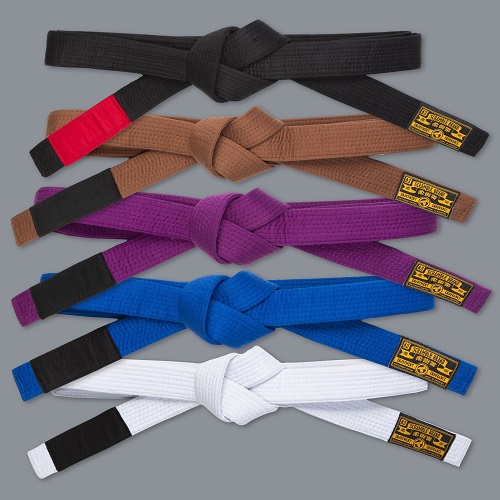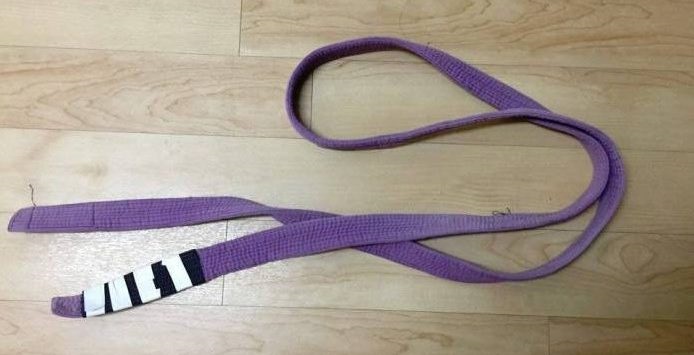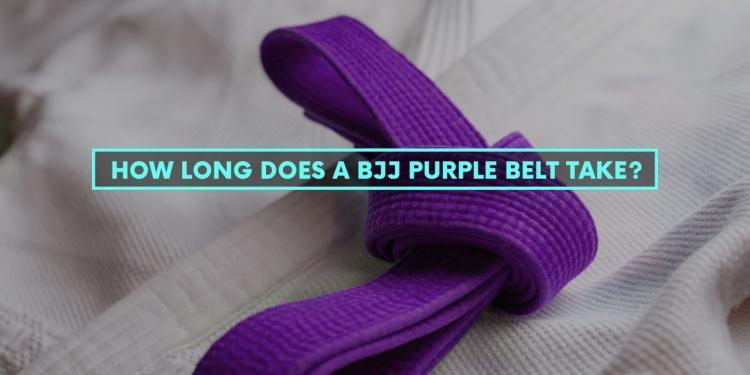We previously wrote about how long a BJJ blue belt takes and summarized that it should take an average of 2-3 years for someone who attends class and rolls regularly. Sadly, that is the highest belt that most BJJ practitioners achieve. For some reason, there is a huge dropoff between blue and purple; most people simply stop practicing and progressing after blue belt. They even coin the term "blue belt blues" when referencing this phenomenon.
So when you get your purple belt, you are in fine company. There aren't many of you. But what does it take to get to purple belt? Below we examine the timeline it gets to purple belt and what it takes to get there.
Promotional Ranking System
Compared to other martial arts, BJJ has the least number of belt colors. So in addition to the color ranking system adopted by many traditional martial arts, most jiu jitsu academies also use stripes as a sign of progress between belt colors. The belts worn by each jiu jitsu practitioner has a black tab at one end of their belt where the stripes, represented by white athletic tapes, wrap around. Traditionally, four stripes need to be earned before progressing to the next ranking. Of course, there are exceptions to this since a teacher could decide to promote any student to the next belt color without having all four stripes.
Adult Ranking System

In jiu jitsu, the adult and children ranking system uses different colors. The practitioner must beat least 16 years old or older before they could receive the adult color ranking of blue and higher, per IBJJF, the governing body for jiu jitsu competition and certification.
The ranking system is as follows followed by IBJJF minimum age requirements:

Factors in Length of Time it Takes to Get to Purple Belt
The average time it takes to obtain a purple belt from a blue belt is approximately 3-5 years depending on class attendance, sparring frequency, and maybe how well you do during competitions. The average length of time from a white belt to purple belt is about 5-8 years. However, this length of time may vary based on the factors listed below.
- Instructors and academies - The promotional criteria between jiu jitsu academies differ from each other.
- Grappling experience - Most practitioners with prior grappling experience, like wrestling, judo, or sambo, will naturally progress faster and get promoted sooner. This matters more for getting your blue belt and less so for getting your purple belt.
- Frequency of training - If you view jiu jitsu as a hobby and show up to class less than 3 times a week, then do not be surprised when the more active teammates get promoted earlier than you.
- Competition oriented - Your decision to compete in jiu jitsu tournaments will normally influence how fast your instructor promotes you. However, being competition oriented does not guarantee a faster promotion. This is especially true if you do not win when you compete; your instructor may actually hold you back if they believe you are not up to par with the competition in your division.
Criteria For BJJ Purple Belt

Before getting your purple belt, here are the things that most coaches look for before promoting you:
Adequate takedowns
Although your coach does not expect your takedowns to be the caliber of a wrestler or even a judoka, they do expect you to at least know at least a couple of go-to takedowns you can land live. At purple belt, you should no longer be relying on guard pulling to get the fight to the ground, although I still see that many higher belts still do that as the preferred method to take the fight to the ground.
Submissions Repertoire Beyond Basic Chokes, Key Lock, Armbars, and Triangles
Once you get to purple, your submission inventory is expected to widen. At blue belt, you will have a few go-to submissions that would include the likes of rear-naked chokes, guillotines, key locks, armbar, triangle, and a few gi-based collar chokes. These are usually the first chokes taught so blue belts are expected to be proficient at them. But as you progress to purple belt, your submission inventory is expected to deepen. At purple, you are expected to land anacondas, d'arce, various other joint locks, and you are also expected to start to become proficient at lower body submissions such as knee bars, heel hooks, and ankle locks.
A White Belt Should Not Be Able To Submit You
At blue belt, you can still be submitted by white belts, especially if they have been training a long time, or if they are wrestlers or judokas with some BJJ experience. But at purple belt, you should not be getting submitted a white belt if you are really rolling with effort. Sorry to say. At purple belt you should have enough mat experience to get yourself out of trouble any white belt puts you in. Of course, this is all given that the white belt is a legitimate white belt, not sandbagging higher belt.
You Can Go Light and Flow, and Do Not Have to Muscle Your Way Out Of Trouble
The previous point takes me to this point. At this point, you should have less of an ego when it comes to rolling with lower belts. You should not have to smash lower belts every time you roll. At blue belt, the chance of getting submitted by a white belt is still very much a possibility. However, when you are at purple belt level, that fear should not be there anymore. So you should be able to have no problems flowing with lower belts and not be afraid to put yourself in disadvantageous positions. And once you are in a disadvantageous position, you should be able to use technique to get yourself out of trouble, and not just muscle your way out of it.
You Can Teach Basic Concepts, Positions, and Submissions
Many gyms that do not have adequate staffing task purple belts with teaching some beginners' classes or stand in as a substitute. Of course you are not expected to know everything or have the answer to most of questions asked. But at purple belt, you are expected to have enough experience on the mats to answer many of the basic questions white belts have regarding concepts, positions, and submissions.




